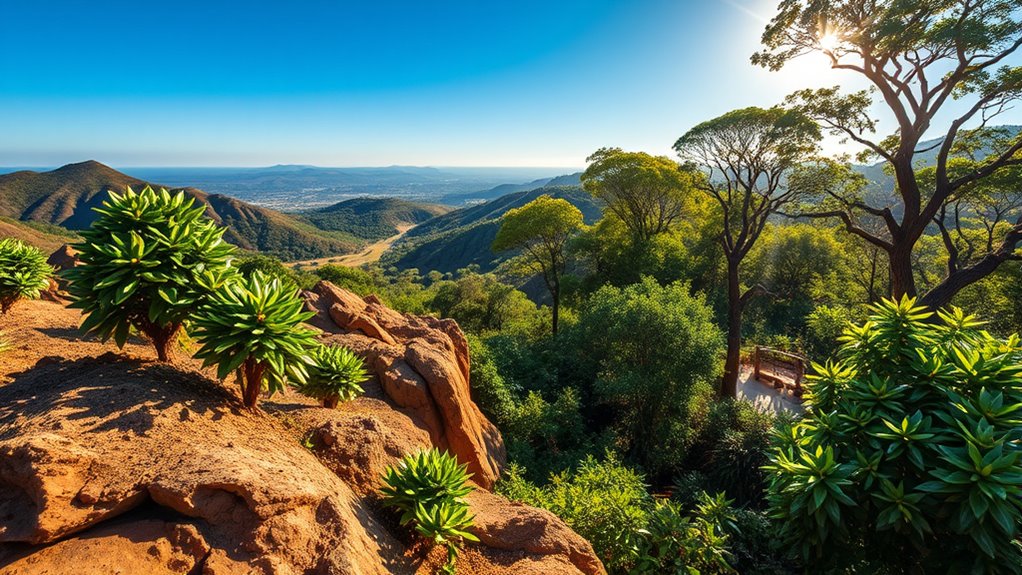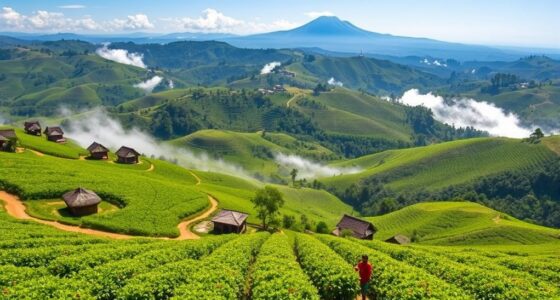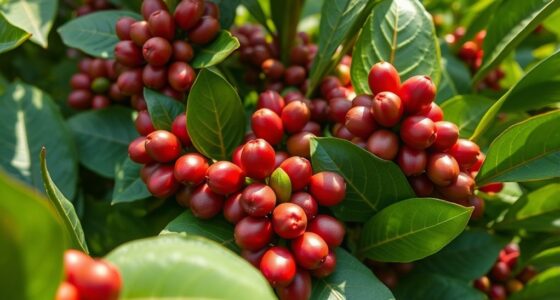You can now grow coffee in unlikely places like California and Australia by using innovative farming techniques, climate adaptation strategies, and urban agriculture methods. Growers select drought-tolerant varieties, create microclimates with greenhouses or shade structures, and harvest rainwater to compensate for changing conditions. These approaches push coffee beyond traditional highland tropics, offering sustainable options and new local markets. Keep exploring to discover how these inventive methods are transforming coffee cultivation worldwide.
Key Takeaways
- Urban coffee cultivation in cities like Los Angeles and Melbourne utilizes rooftop gardens and small plots to grow coffee successfully.
- Climate adaptation strategies, including drought-tolerant varieties and microclimate control, enable coffee growth in non-traditional regions.
- Innovative technologies like greenhouses and shade structures help regulate environmental conditions for coffee cultivation.
- Expanding coffee growth beyond tropics into cities and cooler microclimates broadens geographic possibilities.
- These developments promote sustainable, resilient coffee production and diversify industry options worldwide.

Though coffee is traditionally grown in tropical highlands, innovative farmers are now cultivating it in unlikely places, challenging old assumptions about where coffee can thrive. In urban environments, this shift is especially evident, as urban farming techniques open new avenues for coffee production outside conventional rural settings. Cities like Los Angeles and Melbourne are experimenting with coffee plants on rooftops, balconies, and small plots, demonstrating that with the right climate adaptation strategies, coffee can flourish amidst skyscrapers and concrete. Urban farming not only maximizes limited space but also reduces the carbon footprint associated with importing coffee from distant regions. By integrating coffee cultivation into city landscapes, farmers are fostering local coffee economies and creating fresh, sustainable options for consumers.
Climate adaptation plays a critical role in this unconventional growth. Farmers are selecting resilient coffee varieties that can withstand temperature fluctuations and altered rainfall patterns caused by climate change. In places like California, where droughts and heatwaves are increasingly common, growers are experimenting with drought-tolerant strains and innovative watering techniques, such as drip irrigation and rainwater harvesting. These measures help maintain soil moisture and protect coffee plants from stress. Similarly, Australian farmers are exploring cooler microclimates and shaded environments to grow coffee successfully, even in regions previously considered unsuitable for such crops. This adaptability not only expands the geographic range of coffee but also enhances resilience against climate-related challenges.
The notion of growing coffee in unlikely places isn’t just about location; it’s also about mindset. Farmers and entrepreneurs are leveraging urban agriculture practices and climate-smart technologies to create microclimates that support coffee growth. For instance, greenhouses and shade structures help regulate temperature and humidity, making it possible to cultivate coffee in areas with less-than-ideal natural conditions. These innovations demonstrate that with careful planning, resourcefulness, and a willingness to challenge traditional paradigms, coffee can adapt to diverse environments. The results are exciting—more local coffee options, reduced environmental impact, and greater resilience within the coffee industry.
As you explore this new frontier, you’ll see that the boundaries of coffee cultivation are expanding. Urban farming and climate adaptation are at the forefront of this movement, illustrating that coffee’s future isn’t confined to highland tropics. Instead, it’s becoming a global endeavor, taking root in cities and regions once dismissed as unsuitable. This evolution not only diversifies the coffee landscape but also empowers farmers to innovate in the face of climate change, ensuring coffee’s continued presence across a broader range of environments.
Frequently Asked Questions
Can Coffee Plants Adapt to Extreme Weather Conditions?
You might wonder if coffee plants can handle extreme weather. While they prefer stable climates, some varieties show climate resilience, adapting to droughts or temperature shifts. To succeed, you should focus on crop diversification, planting different coffee strains suited for changing conditions. This approach helps guarantee your coffee production remains steady despite weather extremes, making your farm more resilient and sustainable in the face of climate challenges.
What Are the Best Coffee Varieties for New Growers?
Think of choosing coffee varieties as selecting the perfect companion for your garden’s adventure. For new growers, exotic coffee varieties like Bourbon, SL28, and Geisha offer remarkable resilience and vibrant flavors. These varieties are hardy, showcasing coffee plant resilience even in less-than-ideal conditions. Start with these, and you’ll cultivate not just coffee, but a thriving story rooted in passion and resilience, transforming your land into a lush coffee haven.
How Does Altitude Affect Coffee Flavor Profiles?
Altitude’s impact on coffee is significant because higher elevations typically enhance flavor development. When you grow coffee at higher altitudes, the cooler temperatures slow bean maturation, leading to more complex and nuanced flavor profiles. You’ll notice brighter acidity, vibrant fruit notes, and a cleaner cup. Lower altitudes often produce beans with bolder, heavier flavors, but less complexity. So, choosing the right altitude helps you shape the coffee’s overall taste experience.
What Sustainable Practices Are Used in Unconventional Coffee Farming?
You’re curious about sustainable practices in unconventional coffee farming. You’ll find that farmers use organic pest control to protect crops without harmful chemicals, implement water conservation techniques to preserve resources, and adopt shade-grown methods to promote biodiversity. These practices help minimize environmental impact, support ecosystem health, and ensure long-term productivity. By embracing eco-friendly methods, you contribute to a sustainable future for coffee cultivation in unexpected places.
Are There Legal Restrictions on Coffee Cultivation in These Regions?
You might wonder if legal restrictions or cultivation permits limit coffee farming in these regions. Yes, some areas have regulations to protect native ecosystems, requiring growers to obtain permits before starting cultivation. Local laws can vary, so you should check specific regional restrictions to guarantee compliance. These legal frameworks help balance innovative coffee farming with environmental conservation, making sure your efforts align with regional policies.
Conclusion
So, surprisingly, you can see that cultivating coffee isn’t confined to traditional tropics. From the lush landscapes of California to the expansive expanses of Australia, innovative growers are defying doubts and daring to dream. With dedication, determination, and a dash of daring, you too can discover delightful drinks from these daring, diverse destinations. Embrace the excitement of exploring extraordinary environments; who knows, your next coffee creation might just come from an unlikely, unforgettable place.









